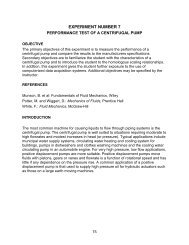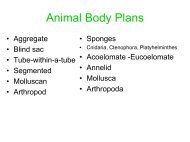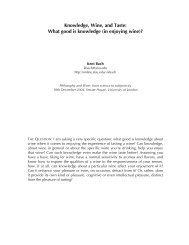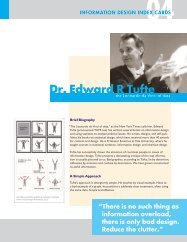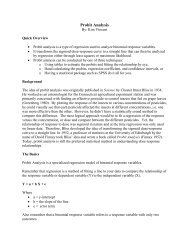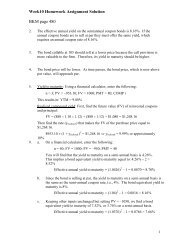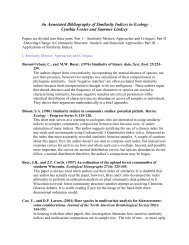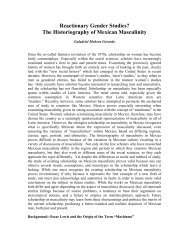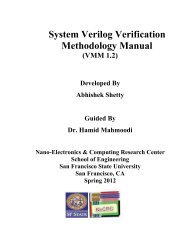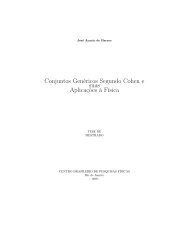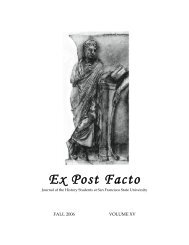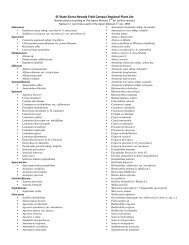Molecular Phylogeny of the Chipmunks Inferred from Mitochondrial ...
Molecular Phylogeny of the Chipmunks Inferred from Mitochondrial ...
Molecular Phylogeny of the Chipmunks Inferred from Mitochondrial ...
You also want an ePaper? Increase the reach of your titles
YUMPU automatically turns print PDFs into web optimized ePapers that Google loves.
338 PIAGGIO AND SPICER<br />
models included <strong>the</strong> Jukes–Cantor model (Jukes and<br />
Cantor, 1969), <strong>the</strong> Kimura two-parameter model<br />
(Kimura, 1980), <strong>the</strong> HKY 85 estimation <strong>of</strong> rate heterogeneity<br />
() estimation <strong>of</strong> invariable sites (I) (Hasegawa<br />
et al., 1985), and <strong>the</strong> general time reversible model <br />
I (Lanave et al., 1984; Rodriguez et al., 1990). The LRT<br />
results in a likelihood ratio statistic (), which is 2 distributed<br />
and allows testing <strong>of</strong> whe<strong>the</strong>r one hypo<strong>the</strong>sis is<br />
significantly better than ano<strong>the</strong>r (Yang et al., 1994).<br />
When a model <strong>of</strong> evolutionary change that fits significantly<br />
better than that <strong>of</strong> parsimony was discovered, a<br />
maximum-likelihood tree was generated by use <strong>of</strong> a random<br />
stepwise addition option <strong>of</strong> <strong>the</strong> heuristic search; 100<br />
replicates were performed. This maximum-likelihood<br />
tree and model were used to generate branch lengths<br />
among taxa and <strong>the</strong> branch lengths were <strong>the</strong>n graphed as<br />
a distribution <strong>of</strong> evolutionary change among <strong>the</strong> taxa.<br />
The maximum-likelihood model was also used to test <strong>the</strong><br />
null hypo<strong>the</strong>sis that <strong>the</strong> sequences were evolving at constant<br />
rates and <strong>the</strong>refore fit a molecular clock (Felsenstein,<br />
1993).<br />
RESULTS<br />
The complete cyt b was sequenced in both directions,<br />
resulting in 1140 aligned base pairs (bp), <strong>of</strong> which 453<br />
sites were variable, and 393 were phylogenetically informative.<br />
The 23 Tamias species and Tamiasciurus<br />
hudsonicus sequences have been deposited with Gen-<br />
Bank under Accession Nos. AF147629–AF147677.<br />
Of <strong>the</strong> 453 variable sites <strong>of</strong> cyt b sequence, <strong>the</strong>re are<br />
77 variable sites in <strong>the</strong> 1st codon position, 28 in <strong>the</strong> 2nd<br />
position, and 348 in <strong>the</strong> 3rd position. The combined<br />
data set <strong>of</strong> COII and cyt b has a total <strong>of</strong> 1824 bases; <strong>of</strong><br />
<strong>the</strong>se <strong>the</strong>re are 648 variable sites. There are 111 variable<br />
sites in <strong>the</strong> 1st codon position, 20 in <strong>the</strong> 2nd<br />
position, and 517 in <strong>the</strong> 3rd position in <strong>the</strong> combined<br />
data set.<br />
Table 3 shows base composition and base composition<br />
bias for <strong>the</strong> cyt b and combined data sets. As with<br />
o<strong>the</strong>r mammalian mitochondrial genes <strong>the</strong> bases are<br />
not found in equal proportions, but <strong>the</strong> rates do not<br />
vary among <strong>the</strong> taxa.<br />
The cyt b sequences were first analyzed under <strong>the</strong><br />
maximum-parsimony model. The cyt b data set contains<br />
65 specimens, including members <strong>of</strong> <strong>the</strong> genera<br />
Tamias, Marmota, Spermophilus, Tamiasciurus, and<br />
Sciurus. A heuristic search resulted in 48 equal trees,<br />
with tree lengths (L) <strong>of</strong> 2652 steps, a consistency index<br />
(CI) <strong>of</strong> 0.299, and a retention index (RI) <strong>of</strong> 0.699. The<br />
results <strong>of</strong> <strong>the</strong> bootstrap analyses are included on a<br />
strict consensus tree <strong>of</strong> <strong>the</strong> 48 most parsimonious trees<br />
(Fig. 1). The branches near <strong>the</strong> tips appear to be well<br />
supported by bootstrapping, but <strong>the</strong> relationships<br />
among <strong>the</strong> clades tend to have lower bootstrap values.<br />
To combine <strong>the</strong> cyt b and COII (Piaggio and Spicer,<br />
2000) data sets, we had to determine that <strong>the</strong>y demon-<br />
TABLE 3<br />
Base Composition Bias for Cytochrome b and <strong>the</strong><br />
Combined Data Set <strong>of</strong> COII and cyt b<br />
1st 2nd 3rd Var All<br />
A 0.272 0.196<br />
Cytochrome b<br />
0.325 0.244 0.289<br />
C 0.432 0.152 0.369 0.395 0.274<br />
G 0.114 0.076 0.016 0.037 0.121<br />
T 0.182 0.576 0.290 0.324 0.315<br />
Bias 0.272 0.435 0.312 0.292 0.171<br />
A 0.209 0.099<br />
Combined<br />
0.335 0.308 0.307<br />
C 0.451 0.197 0.336 0.350 0.261<br />
G 0.087 0.141 0.020 0.035 0.124<br />
T 0.253 0.563 0.309 0.307 0.309<br />
Bias 0.447 0.519 0.453 0.451 0.333<br />
Note. Values are calculated according to codon position (1st, 2nd,<br />
and 3rd, all positions (All), and variable positions only (Var). The<br />
bias is calculated by <strong>the</strong> formula <strong>of</strong> Irwin et al. (1991) and ranges in<br />
value <strong>from</strong> zero to one (zero indicating no bias, one indicating complete<br />
compositional bias).<br />
strated equivalent histories. We performed a partition<br />
homogeneity test in Paup 4.0b2 (Sw<strong>of</strong>ford, 1999),<br />
which revealed that <strong>the</strong> data sets were not significantly<br />
heterogeneous (P 0.86), although <strong>the</strong> tree topologies<br />
for cyt b and COII that resulted <strong>from</strong> parsimony analyses<br />
were slightly different. To determine whe<strong>the</strong>r <strong>the</strong><br />
topologies were statistically different, a Kishino and<br />
Hasegawa (1989) test was performed. The cyt b taxa<br />
set was reduced to be equivalent to <strong>the</strong> COII taxa set,<br />
to have a valid statistical test. The reduction <strong>of</strong> taxa in<br />
<strong>the</strong> cyt b tree resulted in three most parsimonious trees<br />
with 25 taxa. When compared to <strong>the</strong> 95 most parsimonious<br />
COII trees (Piaggio and Spicer, 2000), <strong>the</strong>re was<br />
no statistical difference based on <strong>the</strong> COII data set<br />
under a parsimony Kishino–Hasegawa (1989) test (cyt<br />
b trees one and three: length difference, l.d. 497;<br />
degrees <strong>of</strong> freedom, df 1; standard deviation, SD <br />
7.21597; t 0.2772; P 0.7817; cyt b tree two: l.d. <br />
1; df 1; SD 7.00502; t 0.1428; P 0.8865).<br />
Therefore, <strong>the</strong>re were no significant differences between<br />
<strong>the</strong> gene topologies.<br />
The combined data set has 23 taxa, including Tamias<br />
species and <strong>the</strong> outgroup Tamiasciurus hudsonicus and<br />
Sciurus carolinensis; this is a reduced-taxa data set because<br />
<strong>of</strong> limited COII data available for sciurids. Taxa<br />
representing multiple samples were eliminated so that<br />
only one specimen was left to represent each species. The<br />
combined data set was analyzed by a maximum-parsimony<br />
search that resulted in one tree (L 1777, CI <br />
0.490, RI 0.516). The results <strong>of</strong> <strong>the</strong> bootstrap analyses<br />
are included on <strong>the</strong> most parsimonious phylogram (Fig.<br />
2). Transversional parsimony was performed on <strong>the</strong> com-



